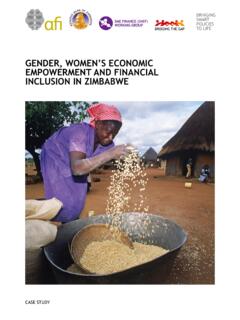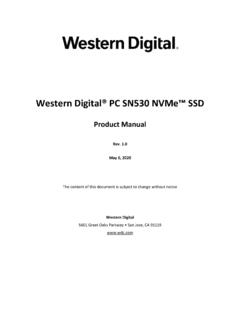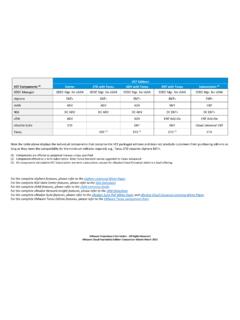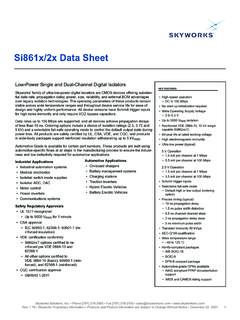Transcription of DIGITAL TRANSFORMATION OF MICROFINANCE AND …
1 BRINGING SMART POLICIES TO LIFEDIGITAL TRANSFORMATION OF MICROFINANCE AND DIGITIZATION OF MICROFINANCE SERVICES TO DEEPEN FINANCIAL INCLUSION IN AFRICAAFI SPECIAL REPORTEXECUTIVE SUMMARY3 INTRODUCTION4 DIGITIZING EXISTING MICROFINANCE OPERATIONS AND OFFERINGS5 Why are MICROFINANCE providers digitizing their 0perations? 5 How MICROFINANCE providers are digitizing their operations: options and requirements 6 Implications for MICROFINANCE providers digitizing operations: prerequisites, challenges and risks9 DIGITAL FINANCE REACHES MICROFINANCE AND CONTRIBUTES TO FINANCIAL INCLUSION10 The contribution of DIGITAL finance to financial inclusion10 The benefits, challenges and risks of DIGITAL finance12 EMERGING SYNERGIES AND PARTNERSHIPS BETWEEN DFS PROVIDERS AND MICROFINANCE PROVIDERS13 Types of partnerships and their benefits13 Contribution of DIGITAL finance and MICROFINANCE partnerships to DIGITAL financial inclusion 16 Benefits.
2 Challenges and risks of DIGITAL finance and MICROFINANCE partnerships16 RECOMMENDATIONS FOR REGULATORS TO ENHANCE SYNERGIES BETWEEN DIGITAL FINANCE AND MICROFINANCE PROVIDERS17 Expectations of regulators and current initiatives 17 Regulatory enablers to maximise synergies between DIGITAL finance and MICROFINANCE providers17 Regulatory approaches to identifying and addressing obstacles to DIGITAL finance and MICROFINANCE 20 CONCLUSION22 DEFINITIONS23 ENDNOTES26 APPENDIXKey informant interviews 30 2018 (August), Alliance for Financial Inclusion. All rights report was commissioned by Alliance for Financial Inclusion (AFI) as part of the Africa Financial Inclusion Policy Initiative (AfPI).
3 The report was prepared by PHB Development under the supervision of the AfPI Expert Group. AFI sincerely thanks its member institutions: Bank of Tanzania, Central Bank of West African States (BCEAO), MICROFINANCE Unit Swaziland and Bank of Uganda for providing their insights. We also like thank stakeholders that participated in the study: Letshego, FINCA Tanzania, Baobab, Fern Software, Musoni Services, InTouch and thanks to the authors of the report: Vera Bersudskaya, Lisa Chassin, Denise Dian, Isabelle Musat and Aurelie Wildt Dagneaux. AFI Staff who contributed to the report: Ali Ghiyazuddin Mohammad, Policy Manager - DIGITAL Financial Services & Efoe P.
4 Koudadjey, Regional Manager, Sub-Saharan Africa & Middle East and North report was made possible with support from Agence Fran aise de D veloppement (AFD). 3 DIGITAL TRANSFORMATION OF MICROFINANCE AND DIGITIZATION OF MICROFINANCE SERVICES TO DEEPEN FINANCIAL INCLUSION IN AFRICA EXECUTIVE SUMMARYD igital financial services (DFS) are spearheading greater financial inclusion in Sub-Saharan Africa, with 338 million registered accounts in 2017 and a significant boost in penetration from 12 percent to 21 percent between 2014 and 2017. Over the past decade of market development, DFS has diversified from basic money transfer and bill payments to credit, cross-border remittances, savings, insurance, merchant payments, bulk disbursements and other value-added services like pay-as-you-go (PAYG) energy, crowdfunding, savings group and value chain digitization.
5 DIGITAL credit offers are growing rapidly in mature DFS markets in Africa, such as Kenya, Tanzania, Uganda and parts of West Africa. Digitization of services is no longer an option, but a race MFIs must run to stay relevant in rapidly evolving providers are taking progressive steps to embrace DIGITAL finance, often starting with the digitization of existing products, services and operations, either by using mobile devices, partnering with a DIGITAL financial service provider or developing a proprietary agency network. Although this triggers benefits for both clients (convenience, security, faster transactions and creation of a DIGITAL footprint) and MICROFINANCE providers (increased operational efficiency, diversification of customer base with value-added products, rural outreach at a lower cost), DIGITAL finance comes with certain challenges and risks, and can sometimes represent a threat if not leveraged providers have to compete with other DFS players by serving millions of traditionally un(der)served populations.
6 Despite the progress in expanding the reach of DFS, many Africans, especially vulnerable segments like rural residents, women and the very poor remain unserved. MICROFINANCE has traditionally focused on serving these groups and have developed methodologies for building relationships with vulnerable clients. Given the scale and rapid rise of DFS and the rural/women focus of MICROFINANCE , partnerships offer great potential to deepen financial inclusion: between MICROFINANCE providers and mobile network operators (on DIGITAL savings and loans, mobile-to-wallet interoperability, etc.) or between MICROFINANCE providers and technical services specialists and FinTechs (credit scoring solutions, blockchains, etc.)
7 As technology disruptions and new players change the face of MICROFINANCE , regulators need to fully comprehend this changing environment and be prepared with adequate supervision and oversight tools. Inclusive DIGITAL finance is contingent on a broader disaggregation of the financial services value chain, with banks and non-banks (including FinTech companies) assuming different responsibilities according to their area of specialization, through a web of partnerships. This could include account and client data storage, management and analytics, and many more. Regulators need to identify how to optimize synergies between DIGITAL finance and MICROFINANCE for financial inclusion, such as consumer protection for DFS, KYC, credit risk management, data privacy, innovation, reporting, financial education and other TRANSFORMATION OF MICROFINANCE AND DIGITIZATION OF MICROFINANCE SERVICES TO DEEPEN FINANCIAL INCLUSION IN AFRICA The expansion of mobile money, the rise of FinTechs and the introduction of blockchain, super platforms and artificial intelligence have all changed the face of financial services.
8 Traditional financial services and channels have evolved from brick and mortar to DIGITAL . The expansion of DIGITAL financial services (DFS) has meant greater financial inclusion. The 2017 Global Findex1 found that billion people (69 percent of the adult population) now have a financial account (bank or mobile money), an increase of billion people since 2011. In Sub-Saharan Africa, one in five adults now has a mobile money account, nearly double the penetration in DIGITAL TRANSFORMATION is also changing the way the MICROFINANCE sector operates. Over the last 10 years, MICROFINANCE providers have been dealing with new entrants to the field (competitors or enablers), leveraging technology to disrupt the way financial services are provided to low-income and unbanked populations.
9 Today, MICROFINANCE providers have to adapt or die , with adaptation ranging from digitizing existing products and services to a complete DIGITAL TRANSFORMATION of processes and the introduction of new products and services (either on their own or with DFS partners).As technology evolves and new solutions for financial services emerge, important questions arise: how will regulators ensure customer data and funds are safe, financial services are high quality and regulatory requirements are met without hindering innovation? As the Alliance for Financial Inclusion (AFI) strives to support the development of regulatory frameworks that deepen financial inclusion in Africa, we must understand the convergence of DIGITAL finance and MICROFINANCE on the continent and explore the implications for financial regulators and study reveals the role of technology in enhancing MICROFINANCE services in Africa and explores the convergence of DFS and MICROFINANCE from different angles.
10 Through extensive literature review and key informant interviews, we sought to understand the synergies between DIGITAL finance and MICROFINANCE providers in providing access to finance for low-income individuals and small businesses. The objective of this report is to present policy and regulatory recommendations that will facilitate the DIGITAL TRANSFORMATION of MICROFINANCE services to deepen financial inclusion in 1 examines the TRANSFORMATION of traditional financial inclusion actors that have digitized their existing operations. We highlight their reasons for digitizing (the value proposition for customers and MICROFINANCE providers, or MFPs), delve into the different models MFPs can use and identify the implications (risks and challenges) for MFPs.











